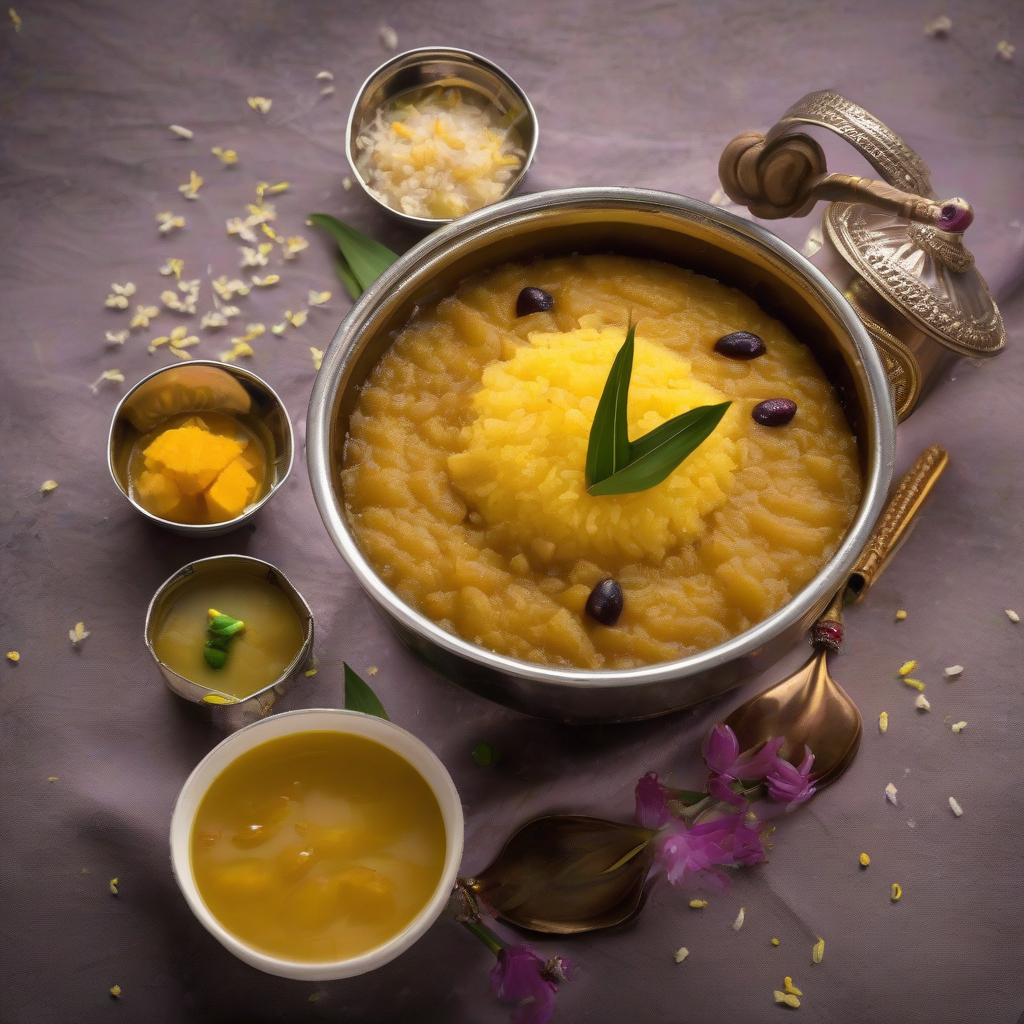Meetha Meetha, Swad Swad: Chef Curry’s Ghee-licious Sweet Pongal Recipe!
Namaste Dosto! Vanakkam! Kem Chho! Sat Sri Akal!
Chef Curry Do’pyaza here, back with another recipe that’s guaranteed to tickle your taste buds and warm your soul. Today, we’re diving into the delicious world of Sweet Pongal, a dish that’s as comforting as a warm hug on a chilly winter morning.
When Do We Eat This Goodness?
Sweet Pongal isn’t just a dish; it’s an emotion, a tradition! You’ll find it gracing tables during Makara Sankranti (the harvest festival), Pongal (especially in Tamil Nadu), and other auspicious occasions in South India. It’s a sweet way to celebrate new beginnings, express gratitude for a bountiful harvest, and share joy with loved ones. Imagine vibrant colours, cheerful music, and the irresistible aroma of Sweet Pongal wafting through the air – that’s the magic of these festivals!
A Little History Lesson (Don’t Worry, It’s Short!)
Pongal has a history that stretches back centuries! It is believed to have originated in South India, and its name, “Pongal,” literally means “to boil over” in Tamil. This symbolizes abundance and prosperity, as the rice and milk boil over the pot during the cooking process. Over time, this humble dish has evolved into the sweet, fragrant delight we know and love today.
Ready to Cook? Let’s Get Started!
- Preparation Time: 15 minutes
- Cooking Time: 45 minutes
What You’ll Need (The Khazana of Ingredients):
- 1 cup Pachai Arisi (Raw Rice) – Use a good quality short-grain rice, like Sona Masuri.
- 1/2 cup Pasiparuppu (Moong Dal) – This adds a lovely nutty flavour.
- 4 cups Paal (Milk) – Full-fat milk gives the richest flavour.
- 1 cup Jaggery (Gud) – Adjust to your sweetness preference. Use the darker variety for a deeper flavour.
- 1/4 cup Sakkarai (Sugar) – White sugar balances the jaggery’s earthiness.
- 1/4 cup Nei (Ghee) – The star of the show! Don’t skimp on the ghee; it adds incredible richness and aroma.
- 1 teaspoon Elaichi Powder (Cardamom Powder) – For that beautiful fragrance.
- 1/4 cup Munthiri (Cashews) – Adds a delightful crunch.
- 1/4 cup Kismis (Raisins) – For a burst of sweetness.
- Pinch of Pachai Karpooram (Edible Camphor) – Just a tiny pinch for an authentic flavour (optional).
Let’s Make Some Magic (The Step-by-Step Guide):
- Wash and Prep: Wash the rice and moong dal thoroughly until the water runs clear. This removes excess starch.
- Roast the Dal (Optional): For an extra nutty flavour, dry roast the moong dal in a pan for 2-3 minutes until it turns slightly golden. Be careful not to burn it!
- Cook the Rice and Dal: In a large, heavy-bottomed pot, combine the rice, moong dal, and milk. Bring to a boil over medium heat, stirring occasionally to prevent sticking.
- Simmer and Stir: Once boiling, reduce the heat to low, cover the pot, and let it simmer for about 20-25 minutes, or until the rice and dal are cooked and softened. Stir occasionally to prevent sticking.
- Melt the Jaggery: While the rice and dal are cooking, melt the jaggery in a separate saucepan with a little water (about 1/4 cup) over low heat. Strain the melted jaggery to remove any impurities.
- Sweeten the Deal: Add the melted jaggery and sugar to the cooked rice and dal mixture. Stir well to combine.
- Ghee-licious Time: Add half of the ghee to the Pongal and stir it in.
- Flavour Bomb: Add the cardamom powder and edible camphor (if using). Mix well.
- Fry the Nuts and Raisins: In a small pan, heat the remaining ghee. Add the cashews and fry until golden brown. Then, add the raisins and fry until they plump up.
- The Grand Finale: Pour the ghee-fried nuts and raisins over the Pongal. Mix gently.
- Serve with Love: Your Sweet Pongal is ready! Serve it hot and enjoy the deliciousness.
Chef Curry’s Tips for Pongal Perfection:
- Don’t Rush: Low and slow cooking is key to achieving the perfect texture and flavour.
- Stir, Stir, Stir: Regular stirring prevents the Pongal from sticking to the bottom of the pot and ensures even cooking.
- Adjust Sweetness: Taste the Pongal and adjust the amount of jaggery and sugar to your liking.
- Ghee is Gold: Use good quality ghee for the best flavour.
Pongal Your Way: Different Cooking Methods:
- Gas Stove: The traditional method, perfect for slow simmering.
- Induction Stove: Works just like a gas stove, but with precise temperature control.
- Pressure Cooker: A quick and easy option. Cook for 2-3 whistles on medium heat. Release the pressure naturally.
- Slow Cooker/Crockpot: Combine all ingredients (except ghee, nuts, and raisins) in the slow cooker and cook on low for 4-6 hours, or on high for 2-3 hours. Add the ghee, nuts, and raisins before serving.
Nutritional Nuggets (Approximate Values per Serving):
- Calories: 350-400
- Protein: 8-10g
- Carbohydrates: 50-60g
- Fat: 15-20g
Serving Suggestions:
- Serve Sweet Pongal hot, garnished with extra ghee and nuts.
- Pair it with savoury dishes like sambar or chutney for a balanced meal.
- Enjoy it as a dessert after a hearty Indian feast.
Time to Cook!
There you have it, my friends! A simple, yet incredibly satisfying recipe for Sweet Pongal. Now, go ahead, put on your aprons, and create some magic in your kitchens. I promise, the aroma and the taste of this dish will transport you to a place of pure bliss.
Don’t forget to try this recipe at home and share the joy with your friends and family.
